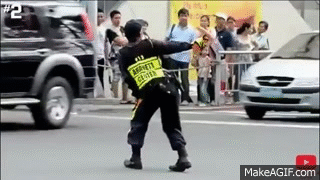I decided to do some research and break the cycle. This is when I discovered the term "flipped classroom". It changed my life. Now, I know what you are saying: "Scott, stop being so dramatic". No, no, honestly it did. From that point on, I began to phase out needless direct instruction, which YES has a place, but not in teaching verb charts as a world language teacher. I began to shift my focus to pre-learning at home for the kids, and stations and real life scenarios at school. I went from sage on the stage, to traffic cop to some mild, controlled chaos.
The next plateau in this journey was when we began to integrate into a Google Apps for Education district. YouTube and Google Forms became my best friend. Walk into my classroom now and you will see (for the most part) students with notes already taken, misconceptions already worked out (again, for the most part) and ready to APPLY and CREATE. Now I do simulations, creation of infographics, Google walking tours with Google maps, videos, skits...it's wonderful. I'm just one person on the flipped bandwagon, but here is what I have found helpful. Happy flipping!
Step 1: Identify the topic.
What do you want your students to learn? Something manageable and age appropriate. I wouldn't go for differential calculus here. Vocabulary, verb charts, simple equations, they all fit here.
Step 2: Find media to support the learning.
It could be a YouTube video you create, someone else has created, an article, an infographic, something that the students can consume at their own pace, on their own time, and repeatedly, if need be. Keep it short and sweet; don't give them War and Peace.
Step 3: Connect the media to a survey/form for your students to fill out after.
I use Google Forms. Edupuzzle is good too! Educannon is wonderful, too, though it comes with a price tag for some of the other features.
Step 4: Distribute and collect.
Have the students complete the activity, collect the results, and plan for instruction. Who needs help? Who is exceeding? How can you adjust instruction, and free up classroom time for fun activities to APPLY learning and have students create.
Step 5: Lather, rinse, repeat. I love Flipped learning. My students know the term flipped learning, and I teach them the benefits of pre-learning with a flipped classroom, and frankly, they get a kick out of it when I make my own videos. I think I have a mini-fandom.
Until next time!
-Scott



No comments:
Post a Comment